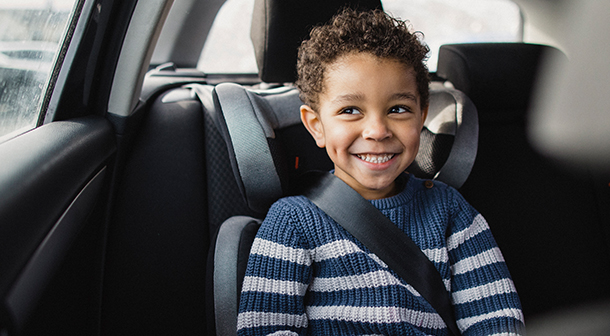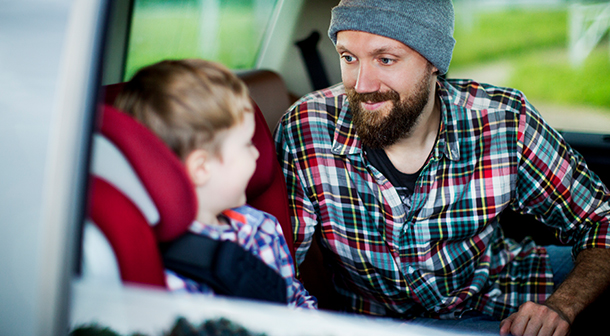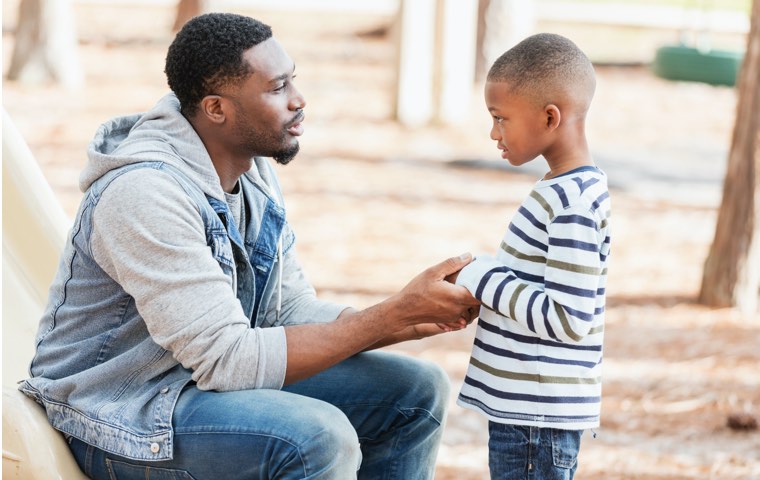Keeping Kids Safe In and Around Cars
By GetParentingTips.com staff
Read Time: 9 Minutes
Driving a new baby home from the hospital for the first time is serious business. You gently fasten him (or her) into the car safety seat, make sure the straps are secure and his neck is supported, and then begin the most careful drive of your life. Car safety is a top priority with precious cargo onboard.
Fast forward a few months and car safety is still important, but life is likely more hectic. With so much to juggle, it's easy for car safety to accidentally take a back seat. The best way to keep kids safe around cars is to create safety habits when they are young.
Car Seats and Seat Belts
Car crashes are the leading cause of death and injury for children 4 years and older. Car seats and safety belts save lives, prevent injuries, and are key to safety in the car.
Follow the recommended guidelines for car safety seats. Make sure your child uses the correct car safety seat for his age and size. In general, keep kids in car seats until they reach the highest weight or height allowed. Every time a child "graduates" to a new car seat, he loses some protection. Children under the age of 13 should always ride in the back seat. Air bags can seriously injure or kill a child in the front seat. And don't forget to make sure every passenger buckles up before you drive off.

Car Seats by Age
To ensure your child is protected while riding in the car, follow the manufacturer's weight and height recommendations. Below is helpful car seat information adapted from the American Academy of Pediatrics.
- Infants and toddlers. Children should be in rear-facing seats in the back seat until they outgrow the height or weight limits. Many children can ride in rear-facing seats until they are 2 years old.
- Toddlers and preschoolers. Children should use forward-facing seats in the back seat until they outgrow the weight or height limits. Many seats can be used by children who weigh up to 65 pounds.
- School-aged children. Children should use a booster seat and the adult lap and shoulder belt in the back seat until they are at least 4 feet 9 inches tall and are between 8 and 12 years old.
- Older children. When children are old enough and large enough for the vehicle's seat belt to fit correctly, they should always use the lap and shoulder belt. All children younger than 13 years should ride in the back seat.
Children under age 13 should always ride in the back seat. Air bags can seriously injure or kill a child in the front seat.
Car safety seats must be properly installed and buckled to give the best protection. Several organizations provide car seat checkups and helpful tips.
- Check out Safe Kids Texas to find a car seat inspection program in your area.
- Sign up for a virtual car safety seat inspection from the Texas Department of Transportation Save Me With a Seat program.
- Let the Safe Kids Worldwide Ultimate Car Seat Guide help you choose, install, and use the right car seat for your child.
Once you have the right car seat properly installed, next up is getting the kids safely buckled. Unfortunately, children often become distracted or uncooperative when it's time to get in the car. Try these tips to make the process of leaving more peaceful.
- Give everyone a few minutes to prepare, and try not to leave at the last minute. Rushing to get in the car can fray everyone's nerves.
- Give an uncooperative toddler options that are focused on getting him in the car, such as, "Do you want me to lift you in to the car, or do you want to climb in?"
- Give older kids the chance to do things for themselves, such as buckling their straps. Talk them through it and praise their success. Be patient if it takes them a little longer. They will get better with practice.
- For kids who don't like riding in the car, give them a positive reason to get in. Use your imagination to make the trip fun, such as offering a special snack, toy, or game you play together only in the car.
- Use some grown-up logic, such as telling them the car won't start until everyone buckles up. Make sure to always buckle your own safety belt before you start the vehicle.
- If nothing else works, gently and firmly buckle them in and talk them through the process. Show that you are in control by keeping your voice calm, which will help your child calm down more quickly.
Replace a car seat if your car is in a wreck, even a minor one. The car seat may be damaged even if the damage is not visible.
Hot Car Safety Tips
After car crashes, heat stroke is the leading cause of vehicle-related deaths in children under 15. Heat stroke happens when a child's body is not able to cool itself quickly enough. Cars heat up fast. The temperature can rise 20 degrees in 10 minutes, and cracking a window does little to keep things cool once the car is turned off.
There are several reasons a child may be alone in a car. Sometimes the child gets into the car on his own, perhaps to play a game, without an adult knowing about it. Sometimes an adult leaves the child in the car to take care of a brief errand. The most common reason is that the driver forgets to take the child out of the car. Often, it's busy parents who are going to work and forget their child is in the back seat, especially if they aren't the one who usually drops him at day care.
Need parenting help now?
The Texas Parent Helpline is available 24/7.
- Call 833-680-0611
- Chat with us
- Text 833-680-0611
Here are some simple habits that can protect your child from the dangers of a hot car.
To prevent leaving a child alone in a car:
- Make it a habit for everyone to get out of the car, even if you're only stopping for a moment.
- Always check the back seat before you get out of the car.
- Create reminders for yourself, such as putting your purse or phone in the back seat safely away from your child and keeping the diaper bag in the front seat beside you.
- If someone else drives your child, check in by phone or text to make sure your child arrives safely.
- Ask your child's caregiver or babysitter to notify you any time your child is more than 10 minutes late arriving.
To prevent a child from gaining access to a car:
- Check the entire car and lock the doors before you step away from it.
- Keep car keys out of the reach of children so they can't unlock the car on their own.
- Keep rear fold-down seats upright and secured to prevent a child from crawling into the trunk from inside the car.
- Make sure children know the car is not a play area. Teach them that the trunk or the inside of any car or truck should never be used for games like hide and seek.
Children love to explore and hide, and sometimes they slip away before you know it. If your child is missing and doesn't respond when you call, first check nearby bodies of water - such as a pool or pond - and then check your vehicle(s), including the trunk.
A child left alone in a vehicle can suffer heat stroke when the outside temperature is as low as 57 degrees.

Driveway and Parking Lot Safety
As a parent, it seems you can't relax even when your child isn't in a car. Children can be injured or killed because a driver couldn't see them while backing up or pulling forward. Toddlers and young children are most at risk because they are small, impulsive, unpredictable, and don't understand how dangerous cars can be.
Here are some tips for keeping kids safe around cars:
- Don't allow children to play on the driveway without adult supervision. If there is a fenced-in area, have children play there instead so they are away from cars.
- Supervise children whenever someone arrives or leaves the home. Many accidents occur because a child wants to say hello or goodbye and gets into the driver's blind spot. This common scenario is known as "bye-bye syndrome".
- If you have available funds, consider adding a backup camera to your vehicle if it doesn't have one. All models made in 2018 or later have a backup camera, but a camera can be added to earlier ones.
- Make a habit of walking all the way around your vehicle and scanning for children before you move the vehicle. If you see or hear children, make sure they have adult supervision and the adult is aware you're starting the vehicle.
- Don't allow toddlers to walk in parking lots. Carry them or use a stroller or shopping cart. Hold hands with older children and teach them to watch for cars backing up because drivers can't see them.
One way to protect children is to make sure they can't leave the house without your knowledge. Consider installing locks at the top of exterior doors or adding door knob safety covers so children can't get outside on their own.
Every outing is a chance to teach car safety lessons to children. For example, when you walk in your neighborhood, you can point out different ways for kids to stay safe around cars.
- A parked vehicle may move at any time. Watch for warning signs such as a running engine, brake lights, or smoke coming from the exhaust pipe.
- Never walk behind or in front of a vehicle that is running. The driver may not see you.
- Never play in parking lots, driveways, streets, or cul-de-sacs without adult supervision.
- When walking on the sidewalk, watch for cars pulling into or out of driveways.

Car Safety Tips for Every Trip
Driving with young children takes planning and patience. You can't always stop kids from fussing or squabbling in the car, but you can take steps to keep yourself calm and in control. Here a few car safety habits that can make every trip more pleasant.
- Plan ahead for your trip. Have the items you need while driving close at hand so you don't have to reach for anything.
- Don't use a mobile device while driving. Texting and talking can wait. If you use your phone to stream music while you drive, set it up before you drive off.
- Pull over and stop in a safe location if you need to tend to a child. Never turn around or reach to the back seat while driving.
- Newer cars are equipped with safety features like backup cameras and automatic emergency braking. Take advantage of the built-in technology but don't take your eyes off the road. Technology is no substitute for careful driving!
- Keep a sense of humor and find fun activities when driving. Kids respond to songs, games, and laughter, and they love knowing you like to be with them. Think of car time as special family time and create some special activities you can share.
Children don't stay little very long. That sweet newborn you took home may be a challenging toddler today, but he'll be learning to drive before you know it. Make car safety a priority to help keep him safe today and in the years ahead.
For more information:
- Child Safety, from the National Highway Traffic Safety Administration
- SaferCar.gov, car seat recall information from the National Highway Traffic Safety Administration
- Safe Kids USA
- HealthyChildren.org, Car Seat: Information for Families
- Texas Department of Public Safety, Child Passenger Safety Information
- National Safety Council, Kids and Hot Cars
- KidsandCars.org, Driveway & Parking Lot Safety




